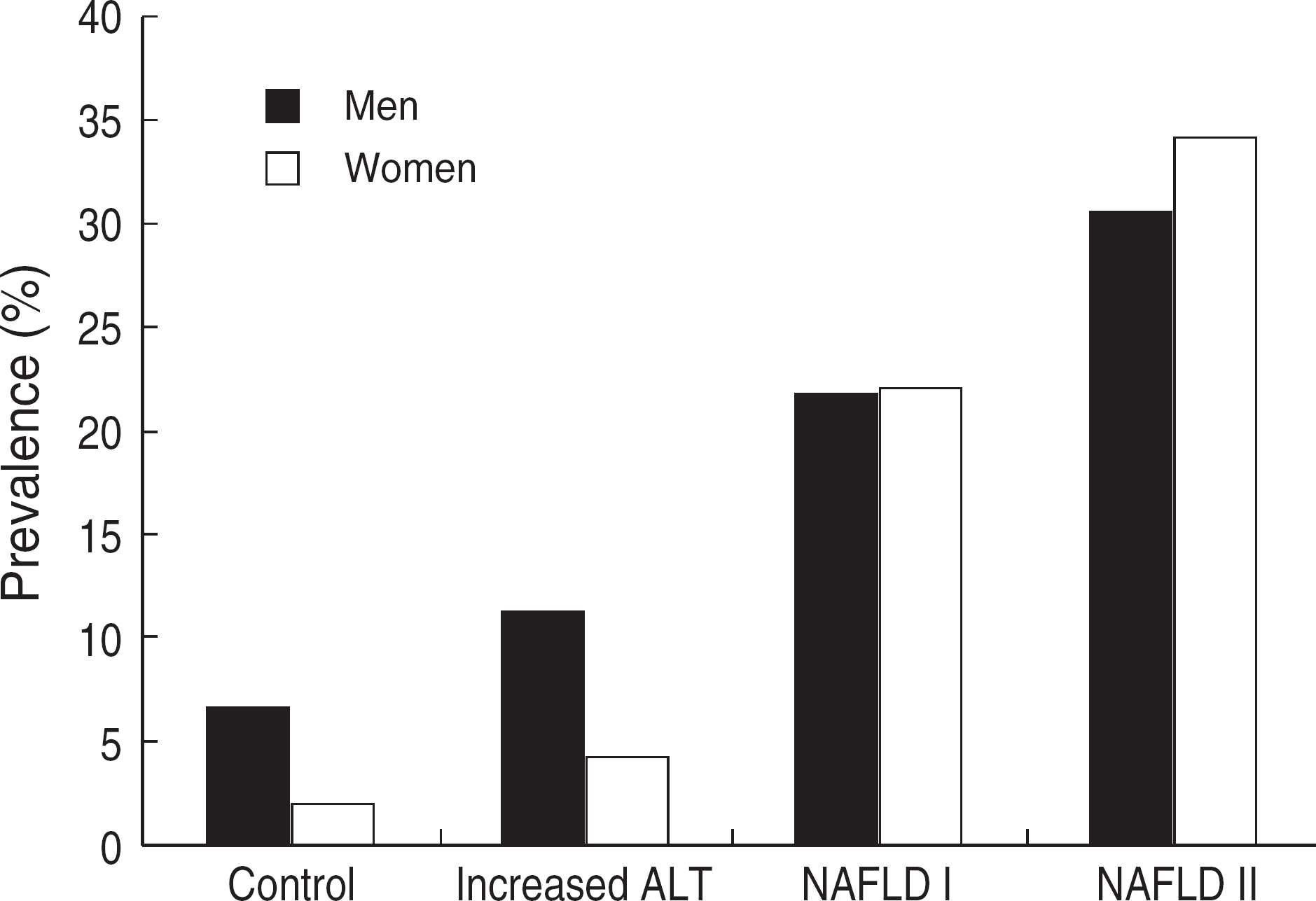1.Hoang KC., Le TV., Wong ND. The metabolic syndrome in East Asians. J Cardiometab Syndr. 2007. 2:276–82.

2.Angelico F., Del Ben M., Conti R., Francioso S., Feole K., Maccioni D, et al. Non-alcoholic fatty liver syndrome: a hepatic consequence of common metabolic diseases. J Gastroenterol Hepatol. 2003. 18:588–94.

3.Falck-Ytter Y., Younossi ZM., Marchesini G., McCullough AJ. Clinical features and natural history of nonalcoholic steatosis syndromes. Semin Liver Dis. 2001. 21:17–26.

4.Choudhury J., Sanyal AJ. Clinical aspects of fatty liver disease. Semin Liver Dis. 2004. 24:349–62.

5.Neuschwander-Tetri BA., Caldwell SH. Nonalcoholic steatohepatitis: summary of an AASLD Single Topic Conference. Hepatology. 2003. 37:1202–19.

6.Villanova N., Moscatiello S., Ramilli S., Bugianesi E., Magalotti D., Vanni E, et al. Endothelial dysfunction and cardiovascular risk profile in nonalcoholic fatty liver disease. Hepatology. 2005. 42:473–80.

7.Shen YH., Yang WS., Lee TH., Lee LT., Chen CY., Huang KC. Bright liver and alanine aminotransferase are associated with metabolic syndrome in adults. Obes Res. 2005. 13:1238–45.

8.Daniel S., Ben-Menachem T., Vasudevan G., Ma CK., Blumenkehl M. Prospective evaluation of unexplained chronic liver transaminase abnormalities in asymptomatic and symptomatic patients. Am J Gastroenterol. 1999. 94:3010–4.

9.Saadeh S., Younossi ZM., Remer EM., Gramlich T., Ong JP., Hurley M, et al. The utility of radiological imaging in nonalcoholic fatty liver disease. Gastroenterology. 2002. 123:745–50.

10.Osawa H., Mori Y. Sonographic diagnosis of fatty liver using a histogram technique that compares liver and renal cortical echo amplitudes. J Clin Ultrasound. 1996. 24:25–9.

11.Saverymuttu SH., Joseph AE., Maxwell JD. Ultasound scanning in the detection of hepatic fibrosis and steatosis. Br Med J (Clin Res Ed). 1986. 292:13–5.
12.Stone NJ., Bilek S., Rosenbaum S. Recent national cholesterol education program adult treatment panel III update: adjustments and options. Am J Cardiol. 2005. 96:53E–9E.

13.Joseph AE., Saverymuttu SH., al-Sam S., Cook MG., Maxwell JD. Comparison of liver histology with ultrasonography in assessing diffuse parenchymal liver disease. Clin Radiol. 1991. 43:26–31.

14.Mendler MH., Bouillet P., Le Sidaner A., Lavoine E., Labrousse F., Sautereau D, et al. Dual-energy CT in the diagnosis and quantification of fatty liver: limited clinical value in comparison to ultrasound scan and single-energy CT, with special reference to iron overload. J Hepatol. 1998. 28:785–94.

15.Layer G., Zuna I., Lorenz A., Zerban H., Haberkorn U., Bannasch P, et al. Computerized ultrasound B-scan texture analysis of experimental diffuse parenchymal liver disease: correlation with histopathology and tissue composition. J Clin Ultrasound. 1991. 19:193–201.

16.Fan JG., Zhu J., Li XJ., Chen L., Li L., Dai F, et al. Prevalence of and risk factors for fatty liver in a general population of Shanghai, China. J Hepatol. 2005. 43:508–14.

17.Browning JD., Szczepaniak LS., Dobbins R., Nuremberg P., Horton JD., Cohen JC, et al. Prevalence of hepatic steatosis in an urban population in the United States: impact of ethinicity. Hepatology. 2004. 40:1387–95.
18.Marchesini G., Bugianesi E., Forlani G., Cerrelli F., Lenzi M., Manini R, et al. Nonalcoholic fatty liver, steatohepatitis, and the metabolic syndrome. Hepatology. 2003. 37:917–23.

19.Chen CH., Huang MH., Yang JC., Nien CK., Yang CC., Yeh YH, et al. Prevalence and risk factors of nonalcoholic fatty liver disease in an adult population of taiwan: metabolic significance of nonalcoholic fatty liver disease in nonobese adults. J Clin Gastroenterol. 2006. 40:745–52.

20.Omagari K., Kadokawa Y., Masuda J., Egawa I., Sawa T., Hazama H, et al. Fatty liver in non-alcoholic non-overweight Japanese adults: incidence and clinical characteristics. J Gastroenterol Hepatol. 2002. 17:1098–105.

21.Adams LA., Angulo P., Lindor KD. Nonalcoholic fatty liver disease. CMAJ. 2005. 172:899–905.
22.Bugianesi E., McCullough AJ., Marchesini G. Insulin resistance: a metabolic pathway to chronic liver disease. Hepatology. 2005. 42:987–1000.

23.Bedogni G., Miglioli L., Masutti F., Tiribelli C., Marchesini G., Bellentani S. Prevalence of and risk factors for nonalcoholic fatty liver disease: the Dionysos nutrition and liver study. Hepatology. 2005. 42:44–52.

24.Zelber-Sagi S., Nitzan-Kaluski D., Halpern Z., Oren R. Prevalence of primary non-alcoholic fatty liver disease in a population-based study and its association with biochemical and anthropometric measures. Liver Int. 2006. 26:856–63.

25.Oh SY., Cho YK., Kang MS., Yoo TW., Park JH., Kim HJ, et al. The association between increased alanine aminotransferase activity and metabolic factors in nonalcoholic fatty liver disease. Metabolism. 2006. 55:1604–9.

26.Kim HC., Choi KS., Jang YH., Shin HW., Kim DJ. Normal serum amino-transferase levels and the metabolic syndrome: Korean national health and nutrition examination surveys. Yonsei Med J. 2006. 47:542–50.

27.Mofrad P., Contos MJ., Haque M., Sargeant C., Fisher RA., Luketic VA, et al. Clinical and histologic spectrum of nonalcoholic fatty liver disease associated with normal ALT values. Hepatology. 2003. 37:1286–92.

28.Powell EE., Cooksley WG., Hanson R., Searle J., Halliday JW., Powell LW. The natural history of nonalcoholic steatohepatitis: a follow-up study of forty-two patients for up to 21 years. Hepatology. 1990. 11:74–80.

29.Ratziu V., Giral P., Charlotte F., Bruckert E., Thibault V., Theodorou I, et al. Liver fibrosis in overweight patients. Gastroenterology. 2000. 118:1117–23.






 PDF
PDF ePub
ePub Citation
Citation Print
Print


 XML Download
XML Download